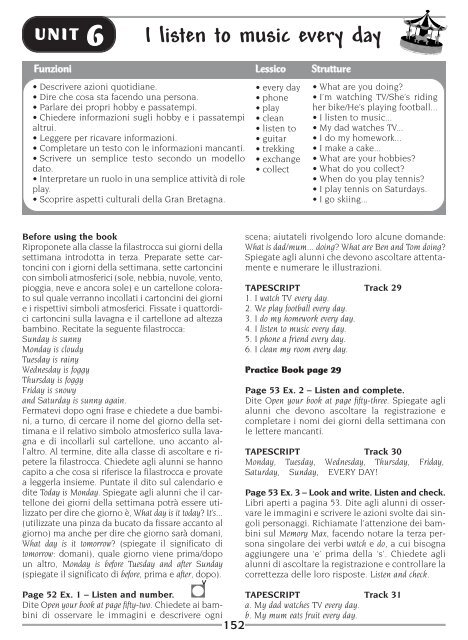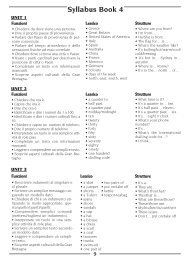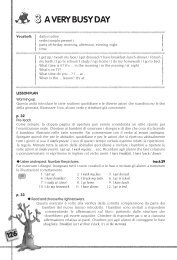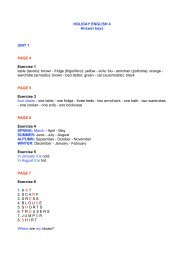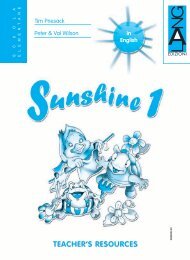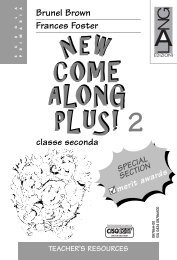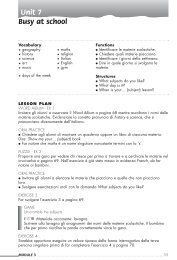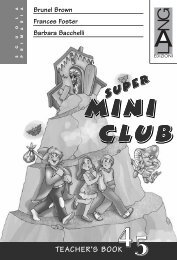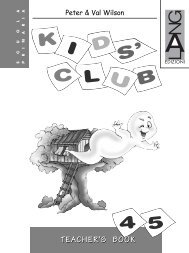I listen to music every day
I listen to music every day
I listen to music every day
Create successful ePaper yourself
Turn your PDF publications into a flip-book with our unique Google optimized e-Paper software.
li rivolgendo alcune domande: What is dad/mum/Jane/Sunita/Ben/Tom doing? Spiegate agli alunni che devonoascoltare attentamente, numerare le illustrazionie infine ripetere le frasi.TAPESCRIPT Track 331. I am phoning a friend.2. She is riding her bike.3. He is playing basketball.4. She is making a cake.5. He is cleaning his bedroom.6. He is reading a book.Page 54 Ex. 6 – Look and complete.Libri aperti a pagina 54. Spiegate agli alunni chedevono osservare le immagini dell’esercizio precedentee completare le frasi utilizzando le parolefornite a fondo pagina.Answers: 1. phoning a friend; 2. riding her bike; 3. playingbasketball; 4. making a cake; 5. cleaning his bedroom;6. reading a bookPage 55 Ex. 7 – Listen and number.Dite Open your book at page fifty-five. Dite agli alunnidi ascoltare la registrazione e numerare le immagininell’ordine in cui vengono descritte, facendoattenzione alla differenza tra le azioni che si svolgonoal momen<strong>to</strong> presente e quelle che invece siripe<strong>to</strong>no tutti i giorni.TAPESCRIPT Track 341. He’s playing basketball.2. She cleans her bedroom <strong>every</strong> <strong>day</strong>.3. He plays basketball <strong>every</strong> <strong>day</strong>4. I make a cake <strong>every</strong> <strong>day</strong>.5. She’s cleaning her bedroom.6. I’m making a cake.FOLLOW UPObiettivo: chiedere e dire che cosa si fa in undetermina<strong>to</strong> giorno• What does he do on Sun<strong>day</strong>s?Preparate alcune carte con verbi (es. read, write,rollerblade, swim, ski, make a cake, watch TV, <strong>listen</strong> <strong>to</strong> theradio, eat fruit etc.), altre con indicati i giorni dellasettimana, una con <strong>every</strong> <strong>day</strong> e alcune con i pronomipersonali (I, she, he) e i nomi di personaggi dellibro (Sunita, Ben, dad, mum). Disponete le carte inordine sparso sulla cattedra avendo cura di tenerleraggruppate per categoria. Invitate i bambini, aturno, a pescare una carta da ogni gruppo, a riordinarleper formare una frase di senso compiu<strong>to</strong> ea mimare l’azione indicata. Rivolgendovi alla classe,chiedete What is he/she doing? e gli alunnidovranno rispondere He/she is… reading a book. Fatepoi leggere al bambino che è alla cattedra la fraseche ha forma<strong>to</strong>, es. Dad watches TV on Satur<strong>day</strong>s.Practice Book page 31Page 55 Ex. 8 – Listen and match.Prima di far svolgere l’esercizio appendete allalavagna il poster delle azioni, Actions – 6, e indicate,uno per volta, i personaggi raffigurati, chiedendoagli alunni di dire che cosa stanno facendo:What is he/she doing?Libri aperti a pagina 55. Dite agli alunni di ascoltarela registrazione e collegare ogni personaggio(Sam, Lilly e David) ai rispettivi hobby.TAPESCRIPT Track 35What are your hobbies, David?My hobbies are playing the guitar and trekking. I play theguitar on Satur<strong>day</strong>. I go trekking in the mountains in thesummer.How about you, Lilly? What are your hobbies?Hmm… My hobbies are horse riding and playing cards. Iride my horse <strong>every</strong> <strong>day</strong>. I play cards with my grandfatheron Sun<strong>day</strong>s.What are your hobbies, Sam?My hobbies are collecting football cards and skiing. I’ve go<strong>to</strong>ne hundred cards. I go skiing with my family in the winter.Page 55 Ex. 9 – Complete. Speak.Libri aperti a pagina 55. Dite agli alunni di completarele frasi utilizzando le informazioni dell’esercizioprecedente. Chiedete agli alunni di esercitarsi,a coppie o in piccoli gruppi, a formulare domandee risposte: What are your hobbies?Answers: a. My hobbies are collecting football cards andskiing. b. My hobbies are horse riding and playing cards. c.My hobbies are playing the guitar and trekking.Practice Book page 32Page 56 Ex.10 – Listen and read.Dite Open your book at page fifty-six. Dite agli alunnidi ascoltare e leggere il tes<strong>to</strong>. Rivolgete alcune domandeper verificarne la comprensione: How old isChris? Where does he live? What is his favourite subject atschool? What are his hobbies?Dite agli alunni di provare a scrivere, sul quaderno,un breve tes<strong>to</strong> sui propri hobby seguendo l’esempiodi ques<strong>to</strong> esercizio.TAPESCRIPT Track 36Hi Johnny!My name’s Chris. I’m Canadian. I live in Ottawa. I’m tenyears old. I’ve got a sister. Her name’s Milly. She’s eight yearsold. My favourite subject at school is maths. I love playingfootball. I play <strong>every</strong> <strong>day</strong> with my friends. My other hobbies areswimming and playing the trumpet. What are your hobbies?Write soon!ChrisPage 56 Ex. 11 – Match.Libri aperti a pagina 56. Dite ai bambini di collegare154
le parole ai disegni corrispondenti. Richiamate l’attenzionedegli alunni sulla sezione Grammar Max, chemette in evidenza come si formulano le domande allaprima e alla terza persona dei verbi non ausiliari.Page 56 Ex. 12 – Write.Libri aperti a pagina 56. Dite ai bambini di leggerela risposta che John scrive a Chris e di completarele frasi, utilizzando le parole fornite nell’esercizioprecedente.Answers: English; ten; brother; geography; basketball; stampsPage 57 Ex. 13 – Listen and read.Questa attività di ascol<strong>to</strong> e di lettura, ricorrente intutte le unità, può essere utilizzata secondo modalitàdiverse:• A libri chiusi, fate ascoltare il dialogo e chiedeteagli alunni di raccontarvene il contenu<strong>to</strong> in italiano.Fate quindi aprire il libro, Open your book at pagefifty-seven, e spiegate ai bambini che devono ascoltareil dialogo leggendolo sul libro. A ques<strong>to</strong> pun<strong>to</strong>,dite agli alunni di esercitarsi, in coppia, a leggeree interpretare il dialogo con la voce e i gesti.• Dite Open your book at page fifty-seven. Spiegate aglialunni che devono leggere e ascoltare attentamenteil dialogo e rispondere alle vostre domandedi comprensione: What is Tom doing? What does hecollect? How many cards has he got? Quindi, proponetel’attività di lettura interpretativa a coppie.TAPESCRIPT Track 37Ben: Hi Tom! What are you doing?Tom: I’m looking at my collection.Ben: What do you collect?Tom: Baseball cards. I love baseball!Ben: How many have you got?Tom: I’ve got one hundred!Ben: One hundred! Wow! Can I have one?Tom: No, sorry, Ben.Ben: But you’ve got one hundred!Tom: They’re my cards!Tom: Oh no! The wind!Ben: Ha! Ha! Now you’ve only got one!Page 57 Ex. 14 – Answer.Libri aperti a pagina 57. Chiedete agli alunni di risponderealle domande di comprensione del tes<strong>to</strong>.Richiamate l’attenzione degli alunni sul MemoryMax, che ricorda come fare le domande per chiederea qualcuno cosa sta facendo e come formularela stessa domanda alla terza persona singolare.Answers: a. Tom is looking at his collection. b. He collectsbaseball cards. c. He has got one hundred.Page 57 Ex. 15 – Role play.Quando gli alunni avranno acquisi<strong>to</strong> familiarità conle strutture del dialogo, chiedete loro di svolgereuna semplice attività di role play (gioco di ruolo).Practice Book page 33UNIT 6Chatter ChumsPage 58 Ex. 16 – Ask and answer.Questa sezione è dedicata al lavoro di coppia: èun valido strumen<strong>to</strong> per ripassare i vocaboli appresie per l’interazione dei bambini, che possonoapprofondire la conoscenza reciproca attraversol’utilizzo di una nuova lingua.Dite Open your book at page fifty-eight. Spiegate aglialunni che, a coppie, devono formulare domandee risposte relative a hobby e collezioni, utilizzandogli spunti offerti dai disegni.Answers: What do you collect? I collect postcards. How manyhave you got? I’ve got forty. What do you collect? I collectrubbers. How many have you got? I’ve got sixty. What doyou collect? I collect badges. How many have you got? I’vegot eighty. What do you collect? I collect bottle <strong>to</strong>ps. Howmany have you got? I’ve got thirty.Life and TraditionsPage 58 Ex. 17 – Listen and number. Repeat.Libri aperti a pagina 58. Dite ai bambini di ascoltarela registrazione e numerare le immagini nell’ordinein cui vengono descritte. Riproponetel’ascol<strong>to</strong> e chiedete agli alunni di ripetere. Fate riferimen<strong>to</strong>all’esperienza personale dei vostri alunniavviando una discussione sulle loro collezionipreferite.TAPESCRIPT Track 381. Children in schools in England like collecting things.2. Many children, especially boys, collect football cards.3. They exchange cards with their friends.4. A collection is complete when they have all the differentcards.Page 58 Ex. 18 – Complete.Libri aperti a pagina 58. Dite agli alunni di completarele frasi utilizzando le informazioni dell’esercizioprecedente e le parole proposte sot<strong>to</strong> il tes<strong>to</strong>.Answers: like; collect; cards; exchange; collection; differentPage 58 Ex. 19 – Write.Dite agli alunni di completare le frasi scrivendoinformazioni relative alle loro collezioni e a quelledi un compagno.Life and Traditions Extension TapescriptChildren all over the world like collecting things. Some thingsare easy <strong>to</strong> collect but others can be difficult <strong>to</strong> find andcan be expensive. Badges are easy <strong>to</strong> collect but collectionsof miniature tea and coffee sets are more difficult <strong>to</strong> find. Somepeople collect foreign coins and notes but they are not easy<strong>to</strong> find, now that most European countries use the euro.Collections of compact discs and sea shells are also popular.Sea shells are easy <strong>to</strong> collect. You can walk along the beachand start a new collection! Football cards, stamps and keyrings are also easy <strong>to</strong> collect and you can exchange themwith your friends. You can also collect miniature perfumebottles. Make sure that you are with your mother or big sister155
when they go <strong>to</strong> a perfumery and ask the shop assistant fora miniature perfume bottle, but don't tell him that it is foryour collection!Curricular CornerPage 59 Ex. 20 – Listen and match.Dite Open your book at page fifty-nine. Dite agli alunnidi ascoltare e collegare ogni parola al disegno corrispondente.TAPESCRIPT Track 39survey results bar chart per centPage 59 Ex. 21 – Look, read and complete.Libri aperti a pagina 59. Spiegate agli alunni chedevono osservare il grafico (bar chart), leggere lepercentuali e completare il tes<strong>to</strong> con i dati acquisiti,utilizzando le parole suggerite sot<strong>to</strong> il tes<strong>to</strong>.Answers: results; survey; bar chart; thirty; twenty; twentyper cent; forty per centPage 59 Ex. 22 – Project.Invitate gli alunni a fare una ricerca in classe suglihobby e le collezioni dei compagni e a creare unposter con una bar chart che ne indichi i risultati.Potete utilizzare la scheda 11 nella sezione Fun andGames di questa unità per far registrare i dati dell’intervistache verranno poi organizzati nell’is<strong>to</strong>gramma.Practice Book page 34Revision RoundaboutPage 60 Ex. 23 – Read and match.Dite Open your book at page sixty. Spiegate agli alunniche devono leggere e collegare il verbo con laparola che consente di formare una frase di sensocompiu<strong>to</strong> e poi con il disegno corrispondente.Answers: do – homework; go – swimming; collect – footballcards; play basketballPage 60 Ex. 24 – Listen and circle.Libri aperti a pagina 60. Dite agli alunni di ascoltarela registrazione e cerchiare gli oggetti che vengononominati.TAPESCRIPT Track 40In my bedroom there are many comics and computer games.There are some tennis balls. I play tennis with my brotheron Satur<strong>day</strong>s. There is a skateboard. I love skateboardingin the park with my friends.Page 60 Ex. 25 – Listen and circle.Fate ascoltare la registrazione e dite ai bambini diindividuare e cerchiare la parola di cui la letteraevidenziata ha una pronuncia diversa dalle altre tre.Listen and circle the different sound.Answer: chairTAPESCRIPT Track 41cards kite comic chairThe Beam Machine S<strong>to</strong>riesPage 60Come nel volume di classe quarta, anche in ques<strong>to</strong>volume la s<strong>to</strong>ria è proposta con le illustrazioni e iltes<strong>to</strong> a fronte, senza fumetti. In ques<strong>to</strong> volume,però, le illustrazioni non sono proposte nell’ordinecorret<strong>to</strong> e l’insegnante potrà fare svolgere unulteriore esercizio rispet<strong>to</strong> agli anni precedenti: lanumerazione delle vingette.La s<strong>to</strong>ria potà essere usata secondo modalità diverse,in base alle competenze linguistiche deipropri alunni.• Fate leggere il tes<strong>to</strong>, Read the s<strong>to</strong>ry on page sixty,prima individualmente e poi a coppie, per confrontarela comprensione del contenu<strong>to</strong>.• Fate osservare le immagini e abbinare il tes<strong>to</strong> adognuna di esse, numerandole.• Fate ascoltare la registrazione seguendo il tes<strong>to</strong>scrit<strong>to</strong> in modo da migliorare la comprensione ela pronuncia delle parole.• Rivolgete domande di comprensione: Where areBen and Sunita? What’s the weather like? What are Benand Sunita doing? What are they wearing? What colour isthe boy’s hair? What colour is the girl’s hair? Where is theman? What is the man doing? What happens <strong>to</strong> the man?What does Ben do? What must Ben and Sunita do?• Fate svolgere alcune attività di riflessione sullalingua (ad esempio individuare descrizioni fisiche,forme in -ing, presente semplice, forma interrogativa,must, can’t, ecc.).Oppure:• Fate ascoltare la registrazione una prima voltacon il libro chiuso e chiedete ai bambini se sonoriusciti a capire l’argomen<strong>to</strong> dell’episodio.• Dite Open your book at page sixty.• Fate leggere il tes<strong>to</strong> e numerare le vignette.• Fate descrivere le immagini: Where are Ben andSunita in the first picture? What’s the weather like? What areBen and Sunita doing? What’s the boy wearing? What colouris his hair? What does the man do in the fourth picture?What are Ben and Sunita doing in the last picture?• Fate ascoltare la registrazione dicendo agli alunnidi seguirne il tes<strong>to</strong> scrit<strong>to</strong> a pagina 60, Listen andread on page sixty, in modo da migliorare la comprensionee la pronuncia delle parole.• Fate svolgere alcune attività di riflessione sullalingua.TAPESCRIPT Track 421. Ben and Sunita are on Earth in 2559. They see the boywith orange hair. He gives them two spacesuits.2. Ben and Sunita must find the man. They fly around theEarth, past the clothes shop on the third cloud and thenewsroom in the sky. They can’t see the man.3. They are very hungry. They see the girl with green hair.She’s sitting in the park. She gives them some ZarzoomBars for lunch.4. Suddenly, Ben sees the man sitting in the park, drinking156
a Zarzoom Cup. Ben and Sunita fly <strong>to</strong> the man and takethe big bag, the crown and the beam machine, becauseit’s theirs, not his.5. The man is very angry and runs after Ben and Sunita.They are very afraid but they are happy because theyhave got the beam machine. The man runs in<strong>to</strong> a tree andfalls down. He can’t get up!6. Ben ties the hands of the man. They have got a lot of things<strong>to</strong> do. They must return the money <strong>to</strong> the bank and theymust give the crown back <strong>to</strong> the Queen. They must gohome and give the beam machine <strong>to</strong> Ben’s father. Benturns on the beam machine and Ben, Sunita and theman all disappear in<strong>to</strong> the beam.FUN AND GAMES 11 • The World Around MeWhat do you collect? page 158Distribuite una fo<strong>to</strong>copia della scheda ad ogni alunno.Dividete la classe in gruppi di quattro o cinquealunni e spiegate che ogni membro del gruppodovrà intervistare alcuni compagni a proposi<strong>to</strong> deglioggetti che amano collezionare (What do you collect?How many have you got?) e registrare le risposte nellatabella. Dite ai bambini di ogni gruppo di suddividersii compagni da intervistare e di iniziare l’attività.Al termine, ogni alunno deve <strong>to</strong>rnare nel propriogruppo e scambiare le informazioni raccolte congli altri membri del gruppo in modo che tutti possanocompletare la tabella con i dati relativi ai compagnidella classe. What does Aldo collect? He collects stamps.How many has he got? He has got..., ecc. Quando tutti igruppi hanno termina<strong>to</strong> l’attività, chiedete di organizzarei dati in un grafico sul quaderno.FUN AND GAMES 12 • From School To HomeSnap! page 159Distribuite due fo<strong>to</strong>copie della scheda ad ognialunno; fate colorare, ritagliare e mescolare benele carte (per rendere il gioco più resistente potetefar incollare le schede su un car<strong>to</strong>ncino). Spiegateagli alunni che, a coppie, devono mettere il pro-UNIT 6prio mazzo di carte capovol<strong>to</strong> sul banco di frontea sé e girare una carta a testa: se le due carte sonouguali, il primo a dire Snap! si prende le due carte;se le due carte non sono uguali, si descrivono epoi si girano altre carte. Dite agli alunni che possonodescrivere l’azione rappresentata sulle cartacome azione abituale (es. I make a cake <strong>every</strong> Satur<strong>day</strong>;I buy comics <strong>every</strong> Fri<strong>day</strong>) oppure come azione che sista svolgendo (I’m making a cake). Vince il gioco chiriesce a prendere il maggior numero di carte.Quando gli alunni hanno acquisi<strong>to</strong> familiarità conil gioco, fatelo riporre nell’apposita cartellina Now,I know e dite di portarlo a casa per giocare con lafamiglia.TEST 6 page 160Exercise 1 – Read and circle.I bambini devono leggere le frasi e cerchiare laforma corretta dei verbi.Answers: a. plays; b. watches; c. reads; d. play; e. does; f. eatExercise 2 – Listen and circle.Dite ai bambini di ascoltare attentamente la registrazionee di cerchiare il disegno che corrispondealla frase proposta.TAPESCRIPT Track 82a. Mark is riding his bike.b. Samantha plays basketball <strong>every</strong> <strong>day</strong>.c. Lindsey is making a cake.d. Jonathan is cleaning his bedroom.e. Phillip reads comics <strong>every</strong> <strong>day</strong>.f. Barbara is phoning a friend.Exercise 3 – Unscramble and write.Invitate i bambini a osservare i disegni e a riordinarele lettere per scrivere le parole.Answers: a. skiing; b. baseball; c. playing cards; d. horseriding; e. playing guitar; f. collecting stamps157
UNIT 6FUN AND GAMES 111The World Around Me• Interview your friends.WHOWHATHOW MANY158
FUN AND GAMES 121From School To HomeUNIT 6• Cut and play.159
TEST 6 Name: .......................................................... Class: .................1. Read and circle. Leggi e cerchia.a. My mum play / plays tennis <strong>every</strong> <strong>day</strong>.b. My sister watch / watches TV <strong>every</strong> <strong>day</strong>.c. My dad read / reads the newspaper <strong>every</strong> <strong>day</strong>.d. I play /plays football <strong>every</strong> <strong>day</strong>.e. My brother do / does his homework <strong>every</strong> <strong>day</strong>.f. I eat / eats fruit <strong>every</strong> <strong>day</strong>.2. Listen and circle. Ascolta e cerchia.3. Unscramble and write. Riordina le lettere e scrivi.a. iigksn .............................. b. bbalseal ..............................c. ylapnig dacsr .............................. d. orshe iignrd ..............................e. pngilya ituagr .............................. f. ctllcoegin mspsta ..............................Date: ...........................................160Mark: ....................................
Funzioni Lessico Strutture• Nominare mezzi di traspor<strong>to</strong>. Parlare deimezzi di traspor<strong>to</strong> utilizzati per raggiungerela scuola.• Parlare dell’orario delle lezioni.• Descrivere l’aspet<strong>to</strong> fisico di una personae il suo abbigliamen<strong>to</strong>.• Leggere e comprendere semplici testi.• Completare un tes<strong>to</strong> con informazioni mancanti.• Scrivere un semplice tes<strong>to</strong> secondo unmodello da<strong>to</strong>.• Interpretare un ruolo in una semplice attivitàdi role play.• Scoprire aspetti culturali della Gran Bretagna.How do you get <strong>to</strong> school?• bus• car• scooter• boat• rocket• open-<strong>to</strong>p bus• tube station• <strong>to</strong>urist map• How do you get <strong>to</strong> school?• By bus/car/bike/on foot.• Come <strong>to</strong> my party.• Take the number 7 bus.• It’s <strong>to</strong>o far.• What time does your school start?UNIT 7161Before using the bookProponete agli alunni l’attività 14 (corredata discheda e spiegazioni per la realizzazione) indicatanella sezione Fun and Games di questa unità.Page 62 Ex. 1 – Listen and number.Repeat.Dite Open your book at page sixty-two. Spiegate aglialunni che devono ascoltare attentamente la registrazione,numerare i mezzi di traspor<strong>to</strong> e ripetere.Richiamate l’attenzione sulla sezione Memory Max,facendo notare la differenza tra by car, by bus e on foot.TAPESCRIPT Track 431. I go <strong>to</strong> school by bus.2. I go <strong>to</strong> school by car.3. I go <strong>to</strong> school by scooter.4. I go <strong>to</strong> school by bike.5. I go <strong>to</strong> school by taxi.6. I go <strong>to</strong> school on foot.7. I go <strong>to</strong> school by tram.8. I go <strong>to</strong> school by train.Page 63 Ex. 2 – Complete.Dite Open your book at page sixty-three. Spiegate aglialunni che devono completare le frasi scrivendo ilnome del mezzo di traspor<strong>to</strong> illustra<strong>to</strong>.Answers: a. by tram; b. by train; c. by scooter; d. by bus;e. on foot; f. by taxi; g. by carPage 63 Ex. 3 – Read and complete.Libri aperti a pagina 63. Chiedete agli alunni dileggere i due biglietti e completarli utilizzando leparole proposte sot<strong>to</strong>.Answers: birth<strong>day</strong>; Satur<strong>day</strong>; party; 29; bus; <strong>to</strong>wn centre.Dear; thank you; love; bike; on; SallyPage 63 Ex. 4 – Listen and check.Libri aperti a pagina 63. Spiegate agli alunni chedevono ascoltare la registrazione e controllare l’esattaesecuzione dell’esercizio precedente.TAPESCRIPT Track 44Dear Sally,It’s my birth<strong>day</strong> on Satur<strong>day</strong>. Please come <strong>to</strong> my party. Myaddress is 29 East Street.Take the number 7 bus from the<strong>to</strong>wn centre. Love, PhilippaDear Philippa,Thank you for your invitation. I love birth<strong>day</strong> parties. I cancome by bike. See you on Satur<strong>day</strong>. Love, SallyFOLLOW UPObiettivo: utilizzare la struttura “I go <strong>to</strong> school…”nella forma affermativa e negativa• Circle whisperingDividete i bambini in due squadre e fateli sederein cerchio. Estraete il nome di un bambino persquadra che dovrà iniziare il gioco; sussurrate unafrase, per es. I go <strong>to</strong> school by car nell’orecchio dei duecaposquadra che, al vostro via, dovranno sussurrarela stessa frase nell’orecchio del bambino accan<strong>to</strong>e così via; l’ultimo bambino dovrà mimarela frase ai suoi compagni di squadra che dovrannopoi formularla correttamente. Si aggiudica un pun<strong>to</strong>la prima squadra che dice correttamente la frase.Ripetete il gioco più volte con alcune varianti; adesempio chiedete che la frase, anziché essere mimata,sia scritta su una lavagnetta o su un foglio(all’inizio non ha importanza se la frase non vienescritta correttamente, ma in segui<strong>to</strong> richiedete anchela correttezza nella scrittura). La prima squa-
dra ad aver scrit<strong>to</strong> la frase dovrà alzare la lavagnae, se la frase è giusta, vince un pun<strong>to</strong>.• I don’t go <strong>to</strong> school by busPreparate alcune flashcards di mezzi di traspor<strong>to</strong> (bike,train, scooter, aeroplane, boat…) e copritene alcune conuna X nera ad indicare la negazione. Dividete laclasse in due squadre e, a turno, chiamate un bambinoper squadra; mostrate due flashcards, una con laX e l’altra normale. Il bambino chiama<strong>to</strong> dovrà formularedue frasi: I don’t go <strong>to</strong> school by… (mezzodi traspor<strong>to</strong> raffigura<strong>to</strong> sulla flashcard con la X); I go<strong>to</strong> school by… (mezzo di traspor<strong>to</strong> raffigura<strong>to</strong> sullaflashcard senza la X). Se le frasi vengono formulatecorrettamente, la squadra vince un pun<strong>to</strong>.Practice Book page 35Page 64 Ex. 5 – Listen and repeat.Dite Open your book at page sixty-four. Fate ascoltarela registrazione e dite agli alunni di ripetere. Richiamatela loro attenzione sugli articoli indeterminativia e an e sul loro uso (a davanti a parole che inizianocon una consonante, an davanti a parole cheiniziano con una vocale).TAPESCRIPT Track 451. an aeroplane 2. a ship 3. a train 4. a ferry5. a bike 6. a rocketPage 64 Ex. 6 – Match.Libri aperti a pagina 64. Spiegate agli alunni chedevono collegare le parole al disegno corrispondente.Proponete ai bambini, come ulteriore attività,di collegare i disegni dell’esercizio 5 al disegnoadat<strong>to</strong> di ques<strong>to</strong> esercizio (es. aeroplane/sky;ship-ferry/sea; train/platform; bike/road; rocket/space).Page 64 Ex. 7 – Read and write.Libri aperti a pagina 64. Dite ai bambini di leggerele frasi e scrivere il nome del mezzo di traspor<strong>to</strong>descrit<strong>to</strong> (dite ai bambini, se non ricordano benele parole, di fare riferimen<strong>to</strong> all’esercizio 5).Answers: 1. It’s a bike. 2. It’s a train. 3. It’s a ship. 4. It’sa ferry. 5. It’s a rocket. 6. It’s an aeroplane.Practice Book page 36Page 65 Ex. 8 – Look and <strong>listen</strong>.Dite Open your book at page sixty-five. Spiegate aglialunni che devono osservare le immagini e ascoltareattentamente la registrazione, cercando di localizzarenel disegno i personaggi che sen<strong>to</strong>no nominare.TAPESCRIPT Track 46Grandfather: Come on! Let’s get on the train. Where isSunita:Ben, Sunita?Ben is at the café with his cousin Tom. He’s How do you get <strong>to</strong> school?buying a drink and his cousin’s eating an ice How do you get <strong>to</strong> school?162cream. Ben’s sister’s eating a sandwich on thebench.Grandfather: OK. Where’s Ben’s mum?Sunita:She’s phoning a friend. Look, there she is,next <strong>to</strong> Ben’s grandmother. She’s sleeping!Grandfather: Oh dear! Where’s his dad?Sunita:Hmm. I’m not sure. Oh, there he is. He’sbuying a newspaper at the newsagent’s.Grandfather: OK, how about Max? Where is he?Sunita: He’s running down the platform!Grandfather: Oh no!Page 65 Ex. 9 – Complete the sentences.Libri aperti a pagina 65. Spiegate agli alunni chedevono osservare le immagini dell’esercizio precedentee completare le frasi inserendo le parolemancanti.Answers: a. father; b. sister; c. mother; d. grandmother; e. dogPage 65 Ex. 10 – Listen and tick. Sing.Prima dell’ascol<strong>to</strong>Dite agli alunni di descrivere le immagini: How doyou get <strong>to</strong> school? By car, on foot…?Durante l’ascol<strong>to</strong>Spiegate agli alunni che devono ascoltare attentamentela canzone e contrassegnare con un tick idisegni citati (la bambina in skateboard non è citata);spiegate il significa<strong>to</strong> di far, lontano: fateavvicinare un compagno all’altro e dite Paolo is nearGiorgio, fate poi spostare uno dei due bambini infondo all’aula e dite: Now Paolo is far from Giorgio.Dopo l’ascol<strong>to</strong>Chiedete ai bambini di dirvi quale mezzo di traspor<strong>to</strong>non è sta<strong>to</strong> menziona<strong>to</strong> nella canzone (skateboard).Riproponete più volte l’ascol<strong>to</strong> chiedendo ai bambinidi cantare tutti insieme; successivamente suddividetela classe in quattro gruppi e assegnateuna strofa ad ogni gruppo; fate cantare e mimarei mezzi di traspor<strong>to</strong> sulla versione strumentale dellacanzone.Quando gli alunni avranno acquisi<strong>to</strong> sicurezza,potete utilizzare la versione strumentale scaricabiledal si<strong>to</strong> www.langedizioni.com/roundabout.La canzone in versione karaoke è presenteanche sul DVD/VHS; è consigliabile, prima dell’utilizzodel DVD/VHS, accostare gli alunni allalettura facendo cantare e seguire il tes<strong>to</strong> dellacanzone nelle apposite pagine in fondo al libro.TAPESCRIPT Track 47How do you get <strong>to</strong> school?How do you get <strong>to</strong> school ?Do you come on foot?No it’s <strong>to</strong>o far!I come by car!
Do you come by bike?No it’s <strong>to</strong>o far!I come by car!How do you get <strong>to</strong> school?How do you get <strong>to</strong> school?Do you come by bus?No it’s <strong>to</strong>o far!I come by car!How do you get <strong>to</strong> school?How do you get <strong>to</strong> school?Do you come by train?No it’s <strong>to</strong>o far!I come by car!Practice Book pages 37/38Page 66 Ex. 11 – Read and answer.Listen and check.Dite Open your book at page sixty-six. Spiegate aglialunni che devono osservare attentamente l’alberogenealogico della famiglia reale inglese, leggerele frasi e rispondere cerchiando la risposta corretta.(Nota: nel disegno mancano Prince Edward ePrincess Eugenie). Successivamente, fate ascoltarela registrazione per controllare la corretta esecuzionedell’esercizio.TAPESCRIPT Track 48a. Is he Prince William’s father?Yes, he is. He’s Prince Charles.b. Is he Prince William’s brother?No, he isn’t. He’s Prince Andrew. He’s William’s uncle.c. Is he Prince William’s uncle?No, he isn’t. He’s Prince Harry. He’s William’s brother.d. Is she Prince Wiliam’s aunt?Yes, she is. She’s Princess Anne.e. Is she Prince William’s cousin?Yes, she is. She’s Princess Beatrice.f. Is she Prince William’s grandmother?Yes, she is! She’s Queen Elizabeth II.Page 66 Ex. 12 – Look and circle.Libri aperti a pagina 66. Dite ai bambini di cerchiarecon il colore indica<strong>to</strong> i diversi significati della ‘s’ afine parola. Per rendere l’esercizio più semplice, lastruttura delle frasi proposte è sempre uguale. Fatecomunque molti esempi prima di far svolgere l’esercizioin modo che gli alunni riescano a identificare ilgius<strong>to</strong> significa<strong>to</strong> della ‘s’, che può essere l’abbreviazionedi is, terza persona del presente del verbo essere(colore verde) o di has, terza persona del presentedel verbo avere (colore viola) oppure può indicarepossesso (genitivo sassone – colore rosso).Page 67 Ex. 13 – Listen and read.Questa attività di ascol<strong>to</strong> e di lettura, ricorrente intutte le unità, può essere utilizzata secondo modalitàdiverse:UNIT 7• A libri chiusi, fate ascoltare il dialogo e chiedeteagli alunni di raccontarvene il contenu<strong>to</strong> in italiano.Fate quindi aprire il libro, Open your book at page sixtyseven,e spiegate ai bambini che devono ascoltare ildialogo leggendolo sul libro. A ques<strong>to</strong> pun<strong>to</strong>, diteagli alunni di esercitarsi a coppie (ogni bambino interpreteràun personaggio) a leggere e interpretareil dialogo con la voce e i gesti.• Dite Open your book at page sixty-seven. Spiegateagli alunni che devono leggere e ascoltare attentamenteil dialogo e rispondere alle vostre domandedi comprensione: Is Frankie late? What timedoes his school start? How does he get <strong>to</strong> school? Howdoes he get <strong>to</strong> school <strong>to</strong><strong>day</strong>? Whose bike is that? Quindi,proponete l’attività di lettura interpretativa acoppie.TAPESCRIPT Track 49Ben: Hi Frankie! Are you late?Frankie: Yes, I am! I don’t like Mon<strong>day</strong>s!Ben: What time does your school start?Frankie: It starts at a quarter <strong>to</strong> nine!Ben: Hmm… It’s twenty-five <strong>to</strong> nine now! How do youget <strong>to</strong> school?Frankie: I go by bus, but the bus leaves at half past eight.Ben: Oh no! Come with me by bike. We can go <strong>to</strong> yourschool first.Frankie: Thanks Ben!Ben: Don’t worry, Frankie. You’re not late now.Frankie: Phew!Ben: We’re here!Frankie: This isn’t my school, Ben! My school is St. Patrick’s,not St. George’s!Ben: Oops! Now you are late!Page 67 Ex. 14 – Answer.Libri aperti a pagina 67. Dite agli alunni di risponderealle domande.Answers: a. It starts at a quarter <strong>to</strong> nine. b. He goes <strong>to</strong> schoolby bus. c. It’s St. Patrick’s.Page 67 Ex. 15 – Role play.Quando gli alunni avranno acquisi<strong>to</strong> familiarità conle strutture del dialogo, chiedete loro di svolgereuna semplice attività di role play (gioco di ruolo).Practice Book page 37/38Chatter ChumsPage 68 Ex. 16 – Ask and answer.Questa sezione è dedicata al lavoro di coppia: èun valido strumen<strong>to</strong> per ripassare i vocaboli appresie per l’interazione dei bambini, che possonoapprofondire la conoscenza reciproca attraversol’utilizzo di una nuova lingua.Dite Open your book at page sixty-eight. Spiegate aglialunni che, a coppie, devono formulare domandee risposte sul modo di raggiungere la loro scuolae l’orario in cui iniziano le lezioni.163
Answers: How do you get <strong>to</strong> school? I go by car. What timedoes your school start? It starts at twenty <strong>to</strong> nine. How doyou get <strong>to</strong> school? I go by bus. What time does your schoolstart? It starts at nine o’clock. How do you get <strong>to</strong> school? Igo on foot. What time does your school start? It starts at aquarter past nine.Life and TraditionsPage 68 Ex. 17 – Listen and repeat. Number.Libri aperti a pagina 68. Dite agli alunni che devonoascoltare la registrazione, ripetere e numerarele immagini nell’ordine corret<strong>to</strong>.TAPESCRIPT Track 501. river boat 2. bus s<strong>to</strong>p 3. The London Eye4. <strong>to</strong>urist map 5. tube station 6. open-<strong>to</strong>p busPage 68 Ex. 18 – Read and complete.Libri aperti a pagina 68. Spiegate agli alunni chedevono leggere il tes<strong>to</strong> e completarlo utilizzandole parole proposte nell’esercizio precedente: Readand complete. Use the words from exercise 17. Chiedeteagli alunni se sono mai stati a Londra e se hannovisita<strong>to</strong> i posti citati nel tes<strong>to</strong>: Have you ever been <strong>to</strong>London? What did you visit? Have you seen the Tower ofLondon/Buckingham Palace? Se ne avete la possibilità,portate i bambini nel labora<strong>to</strong>rio di informaticae invitateli a ricercare immagini delle principaliattrazioni di Londra o, in alternativa, fate portareriviste o depliant di agenzie turistiche da cui ritagliareimmagini per realizzare, a piccoli gruppi, cartellonisu Londra. Proponete, se possibile, la visionedi un video su Londra.Answers: <strong>to</strong>urist map; tube; s<strong>to</strong>ps; open-<strong>to</strong>p; river boat; LondonThere is a magnificent view of London when you are at the<strong>to</strong>p and the weather is not cloudy or foggy! Look carefullyat the London Eye. Can you see it moving?Practice Book page 39Curricular CornerPage 69 Ex. 20 – Listen and number.Dite Open your book at page sixty-nine. Spiegate aglialunni che devono ascoltare la registrazione e numerarei personaggi della famiglia reale britannicanell’ordine in cui vengono elencati.TAPESCRIPT Track 511. She’s Queen Elizabeth II.2. He’s King George V.3. She’s Queen Vic<strong>to</strong>ria.4. He’s King Edward VII.5. He’s King George VI.Page 69 Ex. 21 – Listen and complete.Prima di fare svolgere l’esercizio, proponete ai bambiniuna semplice discussione sull’albero genealogicodelle loro famiglie facendo un breve ripasso deinomi dei componenti della famiglia (mother, father,sister, brother…) e introducete le parole nuove comebisnonno, great-grandfather, bisnonna, great-grandmother,bisnonni great-grandparents, trisnonno greatgreat-grandfather.Libri aperti a pagina 69. Spiegate agli alunni chedevono ascoltare la registrazione e completare lefrasi scrivendo il grado di parentela. Rivolgete delledomande: Who is Queen Vic<strong>to</strong>ria? Is King Edward VIIQueen Elizabeth II’s great-grandfather? ecc.Page 68 Ex. 19 – Write.Libri aperti a pagina 68. Dopo aver mostra<strong>to</strong> immaginio video su Londra, chiedete agli alunni discrivere un breve tes<strong>to</strong> sui luoghi che vorrebberovisitare a Londra. Al temine avviate una discussionesu quali sono stati i posti preferiti dalla classee perché. Write the names of places you want <strong>to</strong> visit inLondon. Come ulteriore attività, proponete aglialunni di scrivere un breve tes<strong>to</strong> sulle attrazionituristiche e i mezzi di traspor<strong>to</strong> della loro città.TAPESCRIPT Track 52She’s Queen Vic<strong>to</strong>ria. She’s Queen Elizabeth II’s great-greatgrandmother.He’s King Edward VII. He’s Queen Elizabeth II’s greatgrandfather.He’s King George V. He’s Queen Elizabeth II’s grandfather.He’s King George VI. He’s Queen Elizabeth II’s father.She’s Queen Elizabeth II. She’s the Queen of England.Page 69 Ex. 22 – Project.Scegliete o fate scegliere ai bambini un’altra famigliareale europea e aiutateli a ricostruirne l’alberogenealogico ricercando informazioni su libri o suInternet (es. la Famiglia Reale di Spagna, del Belgioo del Principa<strong>to</strong> di Monaco).Life and Traditions Extension TapescriptThe most famous clock in England is Big Ben. Big Ben isnext <strong>to</strong> the Houses of Parliament where politicians meet inthe House of Commons and the House of Lords.You can travel in a boat down the river Thames and seemany of the important buildings in London. The Tower of Revision RoundaboutLondon is also on the river Thames. It is the home of the Page 70 Ex. 23 – Find and circle.Crown Jewels, the symbols of the Monarchy in the United Le attività presentate in questa sezione includonoKingdom. The Queen uses the Crown Jewels on very formal esercizi di revisione dei contenuti.occasions. Big black birds called ravens also live in and Dite Open your book at page seventy. Spiegate agli alunniaround the Tower of London. One of the newest and biggest che devono individuare i nomi dei mezzi di traspor<strong>to</strong>landmarks in London is the London Eye. This is a big wheel e cerchiarli.with seats for people <strong>to</strong> sit in as the wheel moves round. Answers: bus; scooter; car; ferry; bike; skateboard.164
Page 70 Ex. 24 – Listen and write. Draw.Dite agli alunni di ascoltare la registrazione e scriverela frase sulla riga sot<strong>to</strong>, poi invitateli a illustrarlanello spazio.TAPESCRIPT Track 53T-h-e-r-e i-s a g-r-e-y c-a-t o-n t-h-e b-o-xPage 70 Ex. 23 – Listen and circle.Fate ascoltare la registrazione e dite ai bambini diindividuare e cerchiare la parola di cui la letteraevidenziata ha una pronuncia diversa dalle altre tre.Listen and circle the different sound.Answer: scooterTAPESCRIPT Track 54book scooter foot lookUNIT 7What colour is the Queen’s dress? Are Ben, Sunita andMax happy in the sixth picture?• Fate ascoltare la registrazione dicendo agli alunnidi seguirne il tes<strong>to</strong> scrit<strong>to</strong> a pagina 70, Listen andread on page seventy, in modo da migliorare la comprensionee la pronuncia delle parole.• Fate svolgere alcune attività di riflessione sullalingua.TAPESCRIPT Track 551. Ben, Sunita and the man are in the attic of Ben’s house.Max is waiting. He is very happy but he barks at the man.2. Ben’s dad comes up the stairs in<strong>to</strong> the attic. Ben explains<strong>every</strong>thing <strong>to</strong> his dad and Mr Price is very angry. Hetelephones the police.3. The police arrive at Ben’s house but Ben’s father doesn’ttell the police about the crown or the machine’s specialpowers. The police take the man <strong>to</strong> prison and the bagwith the money <strong>to</strong> the bank.4. Mr Price tells the children <strong>to</strong> stand next <strong>to</strong> him. He turnson the beam machine and they travel <strong>to</strong> the palace <strong>to</strong> lookfor the Queen.5. Now they are in the palace. Ben introduces his father <strong>to</strong>the Queen. Ben’s father gives the crown <strong>to</strong> the Queen. Sheis very happy and she gives special medals <strong>to</strong> the threebeam machine travellers.6. Ben, Sunita and Mr Price are now back home. Ben’s fatheris happy <strong>to</strong> be home but he is angry with Ben and Sunita.He tells the children they must not play with the beammachine again. Poor children! Poor Ben, poor Sunita…and poor Max!The Beam Machine S<strong>to</strong>riesPage 70Come nel volume di classe quarta, anche in ques<strong>to</strong>volume la s<strong>to</strong>ria è proposta con le illustrazioni e iltes<strong>to</strong> a fronte, senza fumetti. In ques<strong>to</strong> volume,però, le illustrazioni non sono proposte nell’ordinecorret<strong>to</strong> e l’insegnante potrà fare svolgere un ulterioreesercizio rispet<strong>to</strong> agli anni precedenti: la numerazionedelle vingette.La s<strong>to</strong>ria potà essere usata secondo modalità diverse,in base alle competenze linguistiche deglialunni.• Fate leggere il tes<strong>to</strong>, Read the s<strong>to</strong>ry on page seventy,prima individualmente e poi a coppie, per confrontarela comprensione del contenu<strong>to</strong>.FUN• Fate osservare le immagini e abbinare il tes<strong>to</strong> adAND GAMES 13 • The World Around Meognuna di esse, numerandole.I’m green when… page 167• Fate ascoltare la registrazione seguendo il tes<strong>to</strong> Distribuite una fo<strong>to</strong>copia della scheda ad ogni alunno.Discutete con gli alunni dei problemi causatiscrit<strong>to</strong> in modo da migliorare la comprensione ela pronuncia delle parole.dall’inquinamen<strong>to</strong> e dell’importanza di ridurre l’emissionedi gas <strong>to</strong>ssici nell’atmosfera. Spiegate ai• Rivolgete domande di comprensione: Where areBen and Sunita? What are they doing? Is Ben’s dad angry? bambini che l’utilizzo dei mezzi pubblici o di mezziDo the police take the man <strong>to</strong> the prison? What does Ben’s dad non inquinanti può aiutare a ridurre l’inquinamen<strong>to</strong>do? Where are Ben and Sunita now? What does the Queen insieme ad altre misure, come per esempio evitaregive <strong>to</strong> Ben, Sunita and Ben’s father? Why is dad angry? l’uso di bombolette spray, spegnere il mo<strong>to</strong>re quandol’au<strong>to</strong> è ferma, ecc. Dite ai bambini di colorare in• Fate svolgere alcune attività di riflessione sullalingua (ad esempio individuare descrizioni degli rosso le foglie in cui sono illustrati comportamentistati d’animo, forme in -ing, presente semplice, inquinanti e in verde quelle con atteggiamenti corretti;invitate a disegnare ulteriori suggerimentiaggettivi per la descrizione di caratteristiche fisiche,forme negative, aggettivi e pronomi possessivi,membri della famiglia, etc.).tate i bambini a spiegare le illustrazioni: I’m greenanti-inquinamen<strong>to</strong> nelle foglie vuote. Alla fine, invi-Oppure:when I walk, when I use public transport, when I ride my bike,• Fate ascoltare la registrazione una prima volta when I don’t use dangerous sprays, etc.con il libro chiuso e chiedete ai bambini se sonoriusciti a capire l’argomen<strong>to</strong> dell’episodio.FUN AND GAMES 14 • From School To Home• Dite Open your book at page seventy. Fate leggere il How do you get <strong>to</strong> school? page 168tes<strong>to</strong> e numerare le vignette.Distribuite una fo<strong>to</strong>copia della scheda ad ogni alunno.Dividete la classe in gruppi di quattro o cinque• Fate descrivere le immagini: Where are Ben andSunita in the first picture? What are they doing? What can alunni e spiegate che ogni membro del gruppoyou see in the second picture? Who can you see in the third dovrà intervistare alcuni compagni della classe sulpicture? Where are Ben and Sunita in the fifth picture? mezzo di traspor<strong>to</strong> utilizza<strong>to</strong> per andare a scuola165
(How do you get <strong>to</strong> school? Do you come by bike?) e registrarele risposte nella tabella. Dite ai bambini diogni gruppo di suddividersi i compagni da intervistaree di iniziare l’attività. Al termine, ogni alunnodeve <strong>to</strong>rnare nel proprio gruppo e scambiare leinformazioni raccolte con gli altri membri del gruppoin modo che tutti possano completare la tabellacon i dati relativi ai compagni della classe: How doesAldo get <strong>to</strong> school? He goes <strong>to</strong> school by... etc. Quando tuttii gruppi hanno termina<strong>to</strong> l’attività, chiedete aglialunni di organizzare i dati in un grafico sul quaderno.Potete riproporre un’attività simile dando unatlante geografico a ogni gruppo: invitate gli alunnia discutere, in gruppo, su quali mezzi di traspor<strong>to</strong> sipossono utilizzare per andare dalla città in cui vivonoad altre località (es. How can you go from Rome <strong>to</strong>London? I can go by plane, by train or by car and ferry).Fate riporre la scheda nell’apposita cartellina Now,I know e dite ai bambini di portarla a casa per parlaredei mezzi di traspor<strong>to</strong> utilizzati dai compagniper andare a scuola (Maria goes <strong>to</strong> school by bus, Marcogoes <strong>to</strong> school by bike; 10 children go <strong>to</strong> school by car, etc.).TEST 7 page 169Exercise 1 – Listen and complete.I bambini ascoltano la registrazione e completanola tabella.TAPESCRIPT Track 83Girl: This is a class survey on transport. Tom, how doyou get <strong>to</strong> school?Tom: I come by car with my dad.Girl: Do you come by car, Anthony?Anthony: No, I don’t. I come by bus. I get the number sixfrom the <strong>to</strong>wn centre.Girl: What about you, Jennifer?Jennifer: I come on foot with my sister Ellie. She’s fourteen.Girl: OK. And, how do you get <strong>to</strong> school Claire. Do youcome on foot?Claire: No, I don’t. It’s <strong>to</strong>o far. I come by train.Girl: Angela?Angela: I come by bike. I love cycling!Girl: And what about you, Jeremy?Jeremy: I come by skateboard. It’s fun!Exercise 2 – Read and write in full.Dite ai bambini di riscrivere le frasi con la formaestesa dei verbi.Answers: a. has; b. is; c. has; d. has; e. is; f. isExercise 3 – Complete.Invitate gli alunni a completare il tes<strong>to</strong>.Answer: Dear Louise, It’s my birth<strong>day</strong> on Satur<strong>day</strong>. Pleasecome <strong>to</strong> my party. My address is 21 Vicarage Road. Takethe number 12 tram from the <strong>to</strong>wn centre. Love, Anna166
FUN AND GAMES 131The World Around MeUNIT 7I walk.I use public transport.I ride my bike.I use dangerous sprays.I travel by car.I never walk......................................................................... ........................................................................167
UNIT 7FUN AND GAMES 141From School To Home• Interview your classmates.168
Name: .......................................................... Class: ................. TEST 71. Listen and complete. Ascolta e completa.Tom by ...............................................Anthony by ...............................................Jennifer on...............................................Claire by ...............................................Angela by ...............................................Jeremy by ...............................................2. Read and write in full. Leggi e scrivi per esteso.a. Kerry’s got long hair.b. Katie’s wearing a baseball cap.c. Jason’s got two sisters.d. Paul’s got a hamster.e. Angela’s tired.f. Alan’s tall.........................................................................................................................................................................................................................................................................................................................................................................................................................................................................3. Complete. Completa.Dear Louise,It’s ............... birth<strong>day</strong> on Satur<strong>day</strong>. Please ............... <strong>to</strong> my party.My ...................... is 21 Vicarage Road................. the ........................... 12 tram from the ................. centre.Love,AnnaDate: ...........................................169Mark: ....................................
UNIT 8Let’s go on holi<strong>day</strong>!Funzioni Lessico Strutture• Chiedere dove ha intenzione di andareuna persona in vacanza.• Chiedere quando, con quale mezzo ditraspor<strong>to</strong> e con chi andrà.• Chiedere a chi appartiene un ogget<strong>to</strong>.• Dire a chi appartiene un ogget<strong>to</strong>.• Leggere e comprendere semplici testidescrittivi.• Completare un tes<strong>to</strong> con informazionimancanti.• Scrivere un semplice tes<strong>to</strong> secondo unmodello da<strong>to</strong>.• Scoprire aspetti culturali della Gran Bretagna.• sunglasses• dollars• suitcase• passport• guidebook• ticket• passport control• check-in• departure lounge• airport• gate• hurricane• wind• flood• water• bushfire• fire• earthquake• earth• Where are you going?• I’m going <strong>to</strong>…• When are you going?• I’m going in/on…• I’m not going now.• I’m going <strong>to</strong>morrow.• Who are you going with?• I’m going with…• How are you going?• I’m going by…• Whose is this?/Whose are these?• It’s/They’re mine/yours/his/hers.Before using the bookProponete agli alunni l’attività 15 (corredata discheda e spiegazioni per la realizzazione) indicatanella sezione Fun and Games di questa unità.Page 72 Ex. 1 – Listen and number. Repeat.Dite Open your book at page seventy-two. Spiegate aglialunni che devono ascoltare attentamente, numeraregli oggetti nell’ordine corret<strong>to</strong> e ripetere le parole.TAPESCRIPT Track 561. sunglasses 2. dollars 3. suitcase4. passport 5. guidebook 6. ticketPage 72 Ex. 2 – Write.Libri aperti a pagina 72. Dite agli alunni di copiareil nome degli oggetti disegnati, facendo riferimen<strong>to</strong>all’esercizio precedente.Answers: a. passport; b. sunglasses; c. dollars;d. guidebook; e. suitcase; f. ticketdoing a maths test. Richiamate l’attenzione sulla sezioneGrammar Max facendo notare l’utilizzo del presentcontinuous per indicare azioni che sono in fase disvolgimen<strong>to</strong> e azioni programmate per il futuro.TAPESCRIPT Track 58Where are you going? Who are you going with?When are you going? How are you going?Page 73 Ex. 4 – Listen and complete.Libri aperti a pagina 73. Spiegate agli alunni chedevono ascoltare la registrazione e completare iltes<strong>to</strong> con le parole mancanti, che sono le domandeevidenziate nell’esercizio precedente.TAPESCRIPT Track 58a. Boy: Where are you going, Ben?Ben: I’m going <strong>to</strong> the United States.b. Boy: When are you going?Ben: I’m going <strong>to</strong>morrow.c. Boy: Who are you going with?Ben: I’m going with Tom and my family.d. Boy: How are you going?Ben: I’m going by plane.Page 73 Ex. 3 – Listen and repeat. Match.Dite Open your book at page seventy-three. Spiegate aglialunni che devono ascoltare la registrazione, ripeteree collegare le domande all’immagine corrispondente.Dite ai bambini di fare attenzione alledomande, stampate in colori diversi, che saranno Practice Book page 40loro mol<strong>to</strong> utili per chiedere e parlare dei loro programmiper le vacanze. Introducete le espressioninext week e next month rivolgendo delle domande. Peresempio: Are you going <strong>to</strong> the swimming pool next week?Are you going on holi<strong>day</strong> next month? Next week we are immagini nell’ordine corret<strong>to</strong>.171Page 74 Ex. 5 – Listen and number.Dite Open your book at page seventy-four. Fate ascoltarela registrazione e dite agli alunni di numerare le
TAPESCRIPT Track 741. passport control 2. check-in3. departure lounge 4. airport5. gate 6. aeroplane 7. busPage 74 Ex. 6 – Listen and complete.Libri aperti a pagina 74. Spiegate agli alunni chedevono ascoltare attentamente la registrazione ecompletare il tes<strong>to</strong> con le parole mancanti propostea fondo pagina. Fate riascoltare la registrazioneper controllare la corretta esecuzione dell’esercizio.TAPESCRIPT Track 60At the airport, you must go <strong>to</strong> check-in with your suitcases.You must have your passport and ticket. Then, you must go<strong>to</strong> passport control. You must go <strong>to</strong> the correct gate and waitin the departure lounge. A bus sometimes takes you <strong>to</strong> theaeroplane or sometimes you go on foot.FOLLOW UPObiettivo: formulare domande e risposte• Are you going on holi<strong>day</strong>?Dividete la classe in due squadre. Scrivete alla lavagnail nome di alcune località, mezzi di traspor<strong>to</strong>,mesi, giorni e nomi comuni e propri di persona (es.Canada, France, Germany, Italy; by plane, by train, by car;January, February; Mon<strong>day</strong>, Wednes<strong>day</strong>; Sunita, Tom,George, my family, my aunt). Chiamate accan<strong>to</strong> a voiun bambino per ogni squadra e indicate una parolaalla lavagna (es. Canada). A turno, i due bambinidovranno formulare la domanda adeguata: Where areyou going? e la corrispondente risposta: I’m going <strong>to</strong>Canada. Se indicate sulla lavagna un mezzo di traspor<strong>to</strong>,o un mese, o un nome proprio di persona, ledomande e le risposte da formulare saranno rispettivamente:How are you going? I’m going by… When areyou going? I’m going in January/on Mon<strong>day</strong>. Who are yougoing with? I’m going with my family/Sunita. Il bambinoche avrà rispos<strong>to</strong> per primo farà guadagnare unpun<strong>to</strong> alla sua squadra. Continuate il gioco coinvolgendoil maggior numero possibile di alunni.Page 75 Ex. 7 – Listen and number.Dite Open your book at page seventy-five. Spiegate aglialunni che devono ascoltare la registrazione e numerarele fo<strong>to</strong> nell’ordine corret<strong>to</strong>. Chidete ai bambiniche cosa sanno di New York, se qualcuno diloro c’è mai sta<strong>to</strong> e proponete una breve discussionesugli Stati Uniti. Potete chiedere agli alunni diriprodurre su un poster la cartina di un’altra grandecittà americana, per es. Los Angeles, Bos<strong>to</strong>n, ecc. einvitarli a incollare fo<strong>to</strong> trovate su Internet o su rivisteo depliant, con il nome dei posti fo<strong>to</strong>grafati.TAPESCRIPT Track 611. Broadway2. Central Park3. The Empire State Building4. The Yankees Baseball Stadium5. The Statue of Liberty6. 5 th AvenuePage 75 Ex. 8 – Complete the sentences.Libri aperti a pagina 75. Dite agli alunni di completarele frasi inserendo, per ogni giorno, il luogocon lo stesso numero tra quelli elencati nell’esercizioprecedente. Richiamate l’attenzione sulla sezioneGrammar Max facendo notare come si coniugail presente progressivo dei verbi (ossia il verboessere +ing del gerundio).Answers: 1. Broadway; 2. going – Central Park; 3. we aregoing – The Empire State Building; 4. we are going <strong>to</strong> theYankees Baseball Stadium; 5. we are going <strong>to</strong> the Statue ofLiberty; 6. we are going <strong>to</strong> 5 th AvenuePractice Book page 42Page 76 Ex. 9 – Listen and read. Repeat.Dite Open your book at page seventy-six. Spiegate aglialunni che devono ascoltare, leggere e ripetere.Fateli esercitare a coppie utilizzando i nomi deglioggetti scolastici: Whose is this pen? It’s mine. Whoseare these scissors? They’re yours.TAPESCRIPT Track 62Boy: Whose is this hamburger?Girl: It’s mine.Girl: Whose are these fries?Boy: They’re yours.Boy: Whose are these shirts?Girl: They’re his.Girl: Whose is this jumper?Boy: It’s hers.FOLLOW UPObiettivo: comprendere e utilizzare whose e ipronomi possessiviProponete agli alunni l’attività 16 (corredata discheda e spiegazioni per la realizzazione) indicatanella sezione Fun and Games di questa unità.Page 76 Ex. 10 – Listen and complete.Libri aperti a pagina 76. Dite ai bambini di ascoltarela registrazione e rispondere alle domande inserendole parole mancanti. Richiamate l’attenzionesulla sezione Grammar Max facendo notare la differenzatra gli aggettivi e i pronomi possessivi. Spiegateai bambini che alla fine del volume studentetroveranno, riportati nella sezione Great GrammarMax, tutti i possessivi, insieme alla maggior partedelle regole grammaticali introdotte nel corso deicinque volumi.TAPESCRIPT Track 63a. Whose are these tickets?They’re hers.172
. Whose is this cola?It’s yours.c. Whose is this scarf?It’s his.d. Whose are these shoes?They’re mine.Practice Book page 41Page 77 Ex. 11 – Listen and tick. Sing.Prima dell’ascol<strong>to</strong>Dite agli alunni di descrivere i disegni (es. How manychildren are there? Three. What are they doing? They’repacking. What is the girl wearing? A skirt, a blouse, a pair ofsocks and a pair of shoes. What’s the girl’s hair like? It’sblonde).Durante l’ascol<strong>to</strong>Spiegate agli alunni che devono ascoltare attentamentela canzone e segnare con un tick solo idisegni degli oggetti citati nel tes<strong>to</strong> (ticket, dollars,sunglasses, suitcase).Dopo l’ascol<strong>to</strong>Riproponete più volte l’ascol<strong>to</strong> chiedendo ai bambinidi cantare tutti insieme; successivamente suddividetela classe in quattro gruppi e assegnateuna strofa ad ogni gruppo; fate cantare la canzoneuna volta a tutta la classe e poi ogni gruppo dovràcantare la propria strofa.Quando gli alunni avranno acquisi<strong>to</strong> sicurezza,potete utilizzare la versione strumentale scaricabiledal si<strong>to</strong> www.langedizioni.com/roundabout.La canzone in versione karaoke è presente anchesul DVD/VHS; è consigliabile, prima dell’utilizzodel DVD/VHS, accostare gli alunni alla letturafacendo cantare e seguire il tes<strong>to</strong> della canzonenelle apposite pagine in fondo al libro.TAPESCRIPT Track 64We’re going <strong>to</strong> America!Are you ready?Yes! No!Whose is this ticket?It’s his! It’s hers!No! Wait! It’s yours!Oops, it’s mine!We’re going <strong>to</strong> America!Are you ready?Yes! No!Whose are these dollars?They’re his! They’re hers!No! Wait! They’re yours!Oops, they’re mine!We’re going <strong>to</strong> America!Are you ready?Yes! No!Whose are these sunglasses?They’re his! They’re hers!No! Wait! They’re yours!Oops, they’re mine!We’re going <strong>to</strong> America!Are you ready?Yes! No!Whose is this suitcase?It’s his! It’s hers!No! Wait! It’s yours!Oops, it’s mine!UNIT 8Page 77 Ex. 12 – Listen and read. Reply.Spiegate agli alunni che devono ascoltare la registrazionee leggere il tes<strong>to</strong> della car<strong>to</strong>lina inviatada Jimmi. Accertatevi della comprensione del tes<strong>to</strong>facendo delle domande: Where is Jimmi? Is he onholi<strong>day</strong>? What is he doing? Where is Sydney? What’s theweather like? What’s Philip’s address? Chiedete ai bambinidi rispondere alla car<strong>to</strong>lina di Jimmi immaginandodi scrivere da una località dove sono statiin vacanza. (es. Hello Jimmi! I’m having a great time inRome. It’s very hot and sunny. I’m eating an ice cream. I’mgoing <strong>to</strong> the Coliseum <strong>to</strong>morrow. See you soon! Philip)TAPESCRIPT Track 65Hi Philip!I’m having a great time in Sydney. It’s very hot and sunny.I’m sitting on the beach. I’m going <strong>to</strong> the Opera House<strong>to</strong>morrow.See you soon!JimmiPage 78 Ex. 13 – Listen and read.Questa attività di ascol<strong>to</strong> e di lettura, ricorrente intutte le unità, può essere utilizzata secondo modalitàdiverse:• A libri chiusi, fate ascoltare il dialogo e chiedeteagli alunni di raccontarvene il contenu<strong>to</strong> in italiano.Fate quindi aprire il libro, Open your book at pageseventy-eight, e spiegate ai bambini che devono ascoltareil dialogo leggendolo sul libro. A ques<strong>to</strong> pun<strong>to</strong>,dite agli alunni di esercitarsi in gruppi di tre (ognibambino interpreterà un personaggio) a leggere einterpretare il dialogo con la voce e i gesti.• Dite Open your book at page seventy-eight. Spiegateagli alunni che devono leggere e ascoltare attentamenteil dialogo e rispondere alle vostre domandedi comprensione: Where is Amy going? When isshe going <strong>to</strong> France? Who is she going with? Is Sunitagoing with them? Quindi, proponete l’attività di letturainterpretativa a gruppi di tre.TAPESCRIPT Track 66Amy: Hi Sunita! I’m going <strong>to</strong> France!Sunita: OK, have a nice time, Amy. See you soon!Bye!Amy: No, I’m not going now! I’m going <strong>to</strong>morrow.Sunita: Who are you going with?173
Amy: My mum and dad. Where are you goingfor your holi<strong>day</strong>s?Sunita: We’re not going on holi<strong>day</strong> this summer.Amy: Oh no! Why don’t you come with us? Askyour mum, Sunita.Sunita: Please, can I go?Sunita’s mum: I don’t know.Sunita: Please!Sunita’s mum: OK! Let’s find your passport!Sunita/Amy: Hurray!Page 78 Ex. 14 – Answer.Libri aperti a pagina 78. Dite agli alunni di risponderealle domande, cercando le informazioni neltes<strong>to</strong> dell’esercizio precedente.Answers: a. She’s going <strong>to</strong>morrow. b. With her family. c.Yes, she is.Page 78 Ex. 15 – Role play.Quando gli alunni avranno acquisi<strong>to</strong> familiarità conle strutture del dialogo, chiedete loro di svolgereuna semplice attività di role play (gioco di ruolo).Practice Book page 43Chatter ChumsPage 79 Ex. 16 – Ask and answer.Questa sezione è dedicata al lavoro di coppia: èun valido strumen<strong>to</strong> per ripassare i vocaboli appresie per l’interazione dei bambini, che possonoapprofondire la conoscenza reciproca attraversol’utilizzo di una nuova lingua.Dite Open your book at page seventy-nine. Spiegate aglialunni che, a coppie, devono formulare domandee risposte relative a luogo, giorno e persone conle quali hanno pianifica<strong>to</strong> un viaggio, utilizzando isuggerimenti forniti dalle immagini e formulandoneanche altre di propria iniziativa.b. American football players run and use their hands <strong>to</strong> passthe ball. c. The football is oval shaped. d. The players mustget a <strong>to</strong>uchdown <strong>to</strong> win the game.TAPESCRIPT Track 68American people love American football. American football issimilar <strong>to</strong> rugby. It is different from football. American peoplecall football soccer. American football players wear jerseys.They must run and use their hands <strong>to</strong> pass the ball. Thefootball is oval shaped. The players must get a <strong>to</strong>uchdown <strong>to</strong>win the game.Life and Traditions Extension TapescriptThe nearest seaside <strong>to</strong>wn <strong>to</strong> London is Brigh<strong>to</strong>n on the southcoast. At the seaside people buy sticks of rock <strong>to</strong> take homeand <strong>to</strong> give <strong>to</strong> friends. These are made of candy and have thename of the <strong>to</strong>wn inside the rock. Brigh<strong>to</strong>n has a famouspier. On the pier there is a funfair as well as a lot of fortunetellers. Fortune tellers are people who think they know whatis going <strong>to</strong> happen <strong>to</strong> a person in the future! You can stay along time on Brigh<strong>to</strong>n pier as there are a lot of things <strong>to</strong> dolike looking through the special telescope. There are also a lo<strong>to</strong>f things <strong>to</strong> eat such as candy floss and sweets. Remember,there are also a lot of things <strong>to</strong> buy and take home!Curricular CornerPage 80 Ex. 19 – Look and match.Listen and check.Dite Open your book at page eighty. Spiegate agli alunniche devono osservare le fo<strong>to</strong> e collegarle allaparola adatta, in base all’elemen<strong>to</strong> fisico coinvol<strong>to</strong>nel fenomeno in questione. Fate poi ascoltarela registrazione per consentire di controllare lacorrettezza delle risposte.TAPESCRIPT Track 69a hurricane – wind a bushfire – firea flood – water an earthquake – earthLife and TraditionsPage 79 Ex. 17 – Listen and number. Repeat.Libri aperti a pagina 79. Dite ai bambini di ascoltarela registrazione e numerare le fo<strong>to</strong> nell’ordinecorret<strong>to</strong>.TAPESCRIPT Track 671. a football 2. football jerseys 3. a passPage 79 Ex. 18 – Listen and read. Write.Libri aperti a pagina 79. Spiegate agli alunni che devonoascoltare la registrazione e leggere il tes<strong>to</strong> conle informazioni relative al football americano. Chiedetepoi ai bambini di confrontare ed evidenziare ledifferenze tra il calcio e il football americano (adesempio: palla ro<strong>to</strong>nda/ovale; divisa; uso delle mani/deipiedi; regole di gioco.) Invitate poi i bambini acompletare la tabella con le informazioni relative alfootball americano illustrate nel tes<strong>to</strong>.Answers: a. American football players wear jerseys.Page 80 Ex. 20 – Read and complete.Libri aperti a pagina 80. Spiegate agli alunni chedevono leggere il tes<strong>to</strong>, osservare le fo<strong>to</strong> e completarecon le parole mancanti facendo riferimen<strong>to</strong>all’esercizio precedente.Answers: floods, hurricanes, earthquakes, bushfiresPage 80 Ex. 21 – Project.Introducete l’argomen<strong>to</strong> dei cambiamenti climaticie fate svolgere semplici ricerche sulle conseguenzedei cambiamenti del clima in Italia: eruzioni vulcanichefrequenti, inondazioni, valanghe, eccRevision RoundaboutPage 81 Ex. 22 – Read and complete.Le attività presentate in questa sezione includonoesercizi di revisione dei contenuti.Dite Open your book at page eighty-one. Dite agli alunnidi completare il tes<strong>to</strong> inserendo le informazionimancanti suggerite dai disegni.174
Answers: Australia; my family; August; aeroplanePage 81 Ex. 23 – Read and complete.Libri aperti a pagina 81. Dite agli alunni di leggerele frasi e completarle inserendo il pronome possessivoadat<strong>to</strong>.Answers: a. hers; b. mine; c. yours; d. hisPage 81 Ex. 24 – Look and complete.Libri aperti a pagina 81. Spiegate agli alunni chedevono osservare le immagini, leggere le domandee rispondere inserendo il pronome possessivoadat<strong>to</strong>.Answers: hers; mine; his; yoursPractice Book page 44Page 81 Ex. 25 – Listen and circle.Fate ascoltare la registrazione e dite ai bambini diindividuare e cerchiare la parola di cui la letteraevidenziata ha una pronuncia diversa dalle altre tre.Listen and circle the different sound.Answer: familyTAPESCRIPT Track 70family May face playFUN AND GAMES 15 • The World Around MeLet’s go on holi<strong>day</strong>! page 176Dividete la classe in gruppi e dite ad ogni gruppodi immaginare di organizzare una vacanza in unalocalità a scelta. La tabella, da completare con leinformazioni relative al luogo da visitare, consentedi pianificare il viaggio e raccogliere notizieutili sul clima, sulla lingua, sui mezzi di traspor<strong>to</strong>,su città e luoghi da visitare e indumenti da metterein valigia.Fate completare la tabella con l’aiu<strong>to</strong> di libri, rivistee siti Internet e dite agli alunni di presentare ilprodot<strong>to</strong> finale alla classe: Where are you going onholi<strong>day</strong>? When are you going? Who are you going with?How are you going? What do you need?FUN AND GAMES 16 • From School To HomeWhose is this? page 177Distribuite una fo<strong>to</strong>copia della scheda ad ognialunno. Fate colorare i disegni e dite di ritagliarei due dischi. Aiutate i bambini a fissare il discoUNIT 8con la scritta Whose is this?/Whose are these? su quellocon le immagini praticando un foro al centrodelle due ruote, con una matita appuntita, nelquale inserire un fermacampione. Ricordatevi difar tagliare lo spicchio nel disco 1. Per rendere ildispositivo più robus<strong>to</strong>, fate incollare il disco coni disegni su un car<strong>to</strong>ncino rigido. A coppie, diteagli alunni di far ruotare, a turno, il disco superioredella propria ruota e chiedere al compagno dichi sono gli oggetti che compaiono nella finestrella:Whose is this? Whose are these? It’s/they are mine/yours/hers/his.Quando gli alunni hanno acquisi<strong>to</strong> familiarità conil gioco, fate riporre la ruota nell’apposita cartellinaNow, I know e dite di portarla a casa per giocarecon la famiglia.TEST 8 page 178Exercise 1 – Unscramble and write.I bambini osservano i disegni e riordinano le lettereper scrivere le parole.Answers: ticket; airport; passport; departure lounge; suitcase;gateExercise 2 – Complete.Invitate gli alunni a leggere domande e risposte ea completare le domande.Answers: a. Where; b. When; c. Who; d. How; e. When; f. HowExercise 3 – Listen and complete.Dite ai bambini di ascoltare attentamente la registrazionee completare le frasi.TAPESCRIPT Track 84a. Whose is this pen?It’s his.b. Whose are these shoes?They’re hers.c. Whose is that ball?It’s his.d. Whose is this bag?It’s mine.e. Whose are these fries?They’re yours.f. Whose are those chocolates?They’re mine!175
UNIT 8FUN AND GAMES 151The World Around MeWHERE country capital city language..................................... ..................................... .......................................WHEN season month weatherWHO..................................... ..................................... .................................................................................................................................................................................................................................................................................................HOWI go from ................................. <strong>to</strong> ................................. by ................................I go from ................................. <strong>to</strong> ................................. by ................................WHATdocuments:.......................................................................................places <strong>to</strong> visit:• ....................................................................................• ....................................................................................• ....................................................................................• ....................................................................................• ....................................................................................clothes in the suitcase:.....................................................................................................................................................................................................................................................................176
FUN AND GAMES 161From School To HomeUNIT 8• Colour, cut and play.Whose is this?Whose are these?177
TEST 8 Name: .......................................................... Class: .................1. Unscramble and write. Riordina le lettere e scrivi.a. ttkeci ............................ b. prroiat ............................ c. ppsstaor ............................d. tpaeeudrr nlueog ............................ e. saeticus ..................... f. aegt ....................2. Complete. Completa.a. ....................... are you going on holi<strong>day</strong>? I’m going <strong>to</strong> Spain.b. ....................... are you going on holi<strong>day</strong>? I’m going <strong>to</strong>morrow.c. ....................... are you going with? I’m going with my mum and dad.d. ....................... are you going <strong>to</strong> Spain? We’re going by aeroplane.e. ....................... are you going <strong>to</strong> the airport? We’re going <strong>to</strong>morrow morning.f. ....................... are you going <strong>to</strong> the airport? We’re going by car.3. Listen and complete. Ascolta e completa.a. Whose is this pen? b. Whose are these shoes?It’s .............. . They’re .............. .c. Whose is that ball? d. Whose is this bag?It’s .............. . It’s .............. .e. Whose are these fries? f. Whose are those chocolates?They’re .............. . They’re .............. .Date: ...........................................178Mark : ..................................


